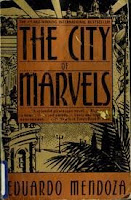City of Marvels
The City of Marvels has
the form of historical fiction and the light touch of magical realism. The fact
that it was recommended to me by a Spanish professor made me read it with an
ear for higher meaning – this is so well disguised in the novel that it may
not actually exist at all. And yet I think it’s there in spades.
 The story – a picaresque tale – begins in Barcelona in 1888,
and it is the two Barcelona world trade fairs of 1888 and 1929 that situate the
story most concretely in time. Early in the narrative, there are, indeed,
explanations of Catalan history that might come out of Robert Hughes’ Barcelona -- readable pleas for the
uniqueness of the culture and for Barcelona’s status from pre-Roman
times. This sets up the background narrator, a shy historian, perhaps. At the
foreground is a young, mysterious stranger whose deeds we soon see are
unscrupulous, as Onofre Bouvila sets about moving from poverty to power and
riches. In the City of Bombs, he begins his journey as an anarchist, but joins
forces with a peddler of a cure for balding; an innate capitalist and
entrepreneur, in other words, with just the occasional recourse into his
repressed social conscience from here on.
The story – a picaresque tale – begins in Barcelona in 1888,
and it is the two Barcelona world trade fairs of 1888 and 1929 that situate the
story most concretely in time. Early in the narrative, there are, indeed,
explanations of Catalan history that might come out of Robert Hughes’ Barcelona -- readable pleas for the
uniqueness of the culture and for Barcelona’s status from pre-Roman
times. This sets up the background narrator, a shy historian, perhaps. At the
foreground is a young, mysterious stranger whose deeds we soon see are
unscrupulous, as Onofre Bouvila sets about moving from poverty to power and
riches. In the City of Bombs, he begins his journey as an anarchist, but joins
forces with a peddler of a cure for balding; an innate capitalist and
entrepreneur, in other words, with just the occasional recourse into his
repressed social conscience from here on.
Apart from improving his finances via the
underworld, Onofre first conquers the landlord’s daughter, Delfina, and then
sets out to win the love of a crime boss’s daughter, Margarita. Their
enforced separation creates some high romance, including a scene where he
sneaks into her room via a ladder, just as a hunchback rival falls also for
Margarita’s charms. But neither Defina or Margarita are Onofre’s true love – this is
saved for the end of the novel, when he lifts off with her like a scene from
Calvino’s Baron of the Trees.
There are many tales to tell and digressions, and although
amoral and downright evil at times, the character and his city are so closely
linked that it may be that Eduardo Mendoza is telling an impossible story for
possible meanings. That is to say – survival, brutality, gentleness,
irreverence, regret – a city’s sins and graces in the life of a man. In more
concrete terms, there is much commentary on the exploitation of Madrid. For
example, this passage feels just as relevant today as ever, in the light of the
present crisis Catalunya crisis:
The government, for its part, sat back and reaped the fruits
of the situation, dragging its heels when it came to tackling Catalonia’s
internal problems, as if Catalonia were just another colony. It dispatched
military troglodytes who know only the language of the bayonet and whose idea
of imposing peace was putting half of mankind to the slaughter (p.173).
The description of the growth of the city – from the
indifference and power of Madrid to the individual corruption of the entire
population – as ‘an eminently mercantile breed’ is one that could be applied to
many cities, Sydney included (see p.196-198). The separation of haves and
have-nots, nonetheless, gives some sympathy to Onofre’s attempts to beat the
system, or rise above it, until of course his tricks are worse than any others
when it comes to property speculation and its social effects.
Onofre isn’t content to grow rich through property alone –
he is inspired at times to invest in early cinema, the illegal arms trade,
aviation. The author puts all this into an historical context that places
Barcelona as a would-be major player in this historical re-writing (as a nation
that is often treated as a colony, the stories speak volumes for the status
desired, and ironically but not unsympathetically treated by the author). As an
Australian, I get all this – for we too are a country of inventors whose ideas
are often attributed elsewhere. Indeed, I can think of a great
comparative study to an Australian novel published in the
1980s, whose title I will keep to myself at the moment. Let’s put that down as a project for the future. After all, as Onofre’s
life demonstrates, life is long and full of possibilities for those with the
inclination to grasp at ideas floating out there in the ether.



Comments
Post a Comment